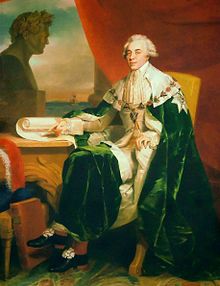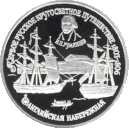Nikolay Rumyantsev
Nikolay Rumyantsev | |
|---|---|
 A portrait by George Dawe | |
| Ministers of Foreign Affairs of the Russian Empire | |
| In office 1808–1814 | |
| Chancellor of the Russian Empire | |
| In office 1809–1826 | |
| Personal details | |
| Born | 1754 |
| Died | 1826 |
| Parent(s) | Pyotr Rumyantsev, Yekaterina Rumyantseva |
| Education | Leiden University |
| Signature | |
Count Nikolai Petrovich Rumyantsev (
Background
Rumyantsev and his brother were provided with basic education at home. Their mentor was Friedrich Melchior, Baron von Grimm. In 1774 they went to Leiden University where they studied history, law and language.[1]
Official career
Rumyantsev was the first envoy of Russia to the Holy Roman Empire after Russia became a guarantor of the imperial constitution through the Treaty of Teschen (1779). He arrived in 1782 accredited as ambassador to the Electoral Rhenish Circle, Upper Rhenish Circle, Swabian Circle, Franconian Circle, Electorate of Mainz, Electorate of Cologne, Palatine Zweibrücken, Duchy of Württemberg, Margraviate of Baden and Landgraviate of Hesse-Kassel. Although he acted as the representative of Russia as guarantor of the peace, he was considered by Germans to be a partisan of Austria.[2]
During the first years of the 19th century, Rumyantsev was very influential with
As Foreign Minister (appointed 1808), he advocated a closer alliance with France. Represented Russia at the
Nicholas Rumyantsev died on 3 January 1826 in his
Scholarly pursuits

During the years of his foreign service, Nikolay Petrovich amassed a huge collection of historical documents, rare coins, maps, manuscripts, and
Rumyantsev also became a notable patron of the Russian voyages of exploration. He sponsored the first Russian circumnavigation of the globe. He also funded the Rurik expedition led by Otto von Kotzebue.[3] As a result, his name came to be attached to such exotic things as:
- Spiranthes romanzoffiana, a North American orchid
- Papilio rumanzovia, a large butterfly from the Philippines
- Syagrus romanzoffiana, the Queen or Coco Palm tree of South America
- Romanzoffia, a genus of flowering plants in the waterleaf family from North America
- Romanzovite, another name for grossular, a type of garnet stone
- between 1812 and 1842 the Russian name (залив Румянцева) for present day Bodega Bay, California
- the Romanzof Mountainsin Alaska and Yukon territory
- Cape Romanzof in Alaska, itself giving its name to Cape Romanzof LRRS Airport
- Romanzov Island, now called Tikei
- Romanzoff Bay, in La Pérouse Strait
In 1811 he commissioned sculptor Canova to create a statue of peace in recognition of the peacemaking efforts of his family.[4][5]
References
- ^ Бекасова, А. В. (1995). ""Учёные занятия" русского аристократа как способ самореализации (на примере графа Н. П. Румянцева)". Вопросы истории естествознания и техники. 1: 27 – via Институт истории естествознания и техники имени С. И. Вавилова РАН.
- ^ Karl Otmar Freiherr von Aretin, "Russia as a Guarantor Power of the Imperial Constitution under Catherine II", Journal of Modern History 58, Supplement (1986): S141–S160.
- ^ Sterling, Paul Gary (2011). "The Voyage of the Rurik". The Argonaut. 22 (2): 8 – via Internet Archive.
privately funded and directed as a scientific expedition by a Russian nobleman
- ^ "Antonio Canova (1757-1822) Italian, Rome, 1814. Bust of Peace". Sotheby's. 2018. Retrieved 19 August 2022.
Count Nikolai P. Rumyantsev and the Commission of the Statue of Peace
- ^ Cirigliano, Rosanna (13 May 2022). "'Peace' from Kyiv Displayed in Palazzo Vecchio". Magenta Publishing Florence. Retrieved 2022-08-19.
This article needs additional citations for verification. (December 2009) |
